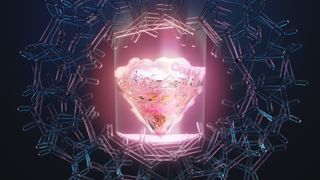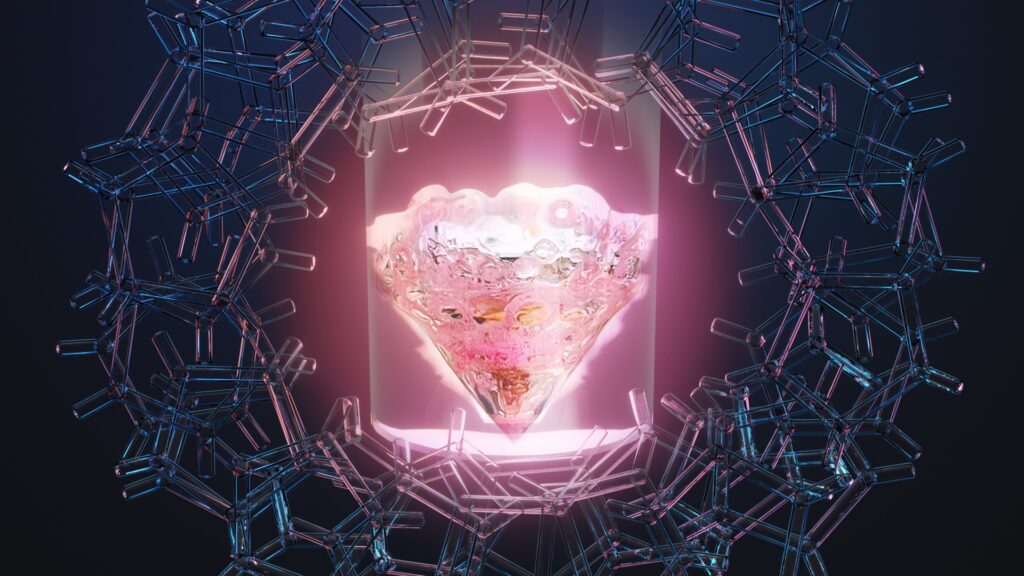
Conceptual art showing the rare earth element promethium in a vial surrounded by an organic ligand. ORNL scientists have discovered hidden features of promethium, opening a pathway for research into other lanthanide elements.
(Image credit: Jacquelyn DeMink, art; Thomas Dyke, photography; ORNL, U.S. Dept. of Energy)
For the first time, scientists have revealed crucial properties of the mysterious, radioactive substance promethium — nearly eight decades after the elusive rare earth element was discovered.
Promethium is one of the 15 lanthanide elements at the bottom of the periodic table. Also known as the rare earths, these metals exhibit a number of useful properties, including strong magnetism and unusual optical characteristics, making them particularly important in modern electronic devices.
“They are used in lasers; they are part of the screens of your smartphone. They are also used in very strong magnets in wind turbines and electric vehicles,” Ilja Popovs, a research and development staff member at Oak Ridge National Laboratory (ORNL) and co-author of a new study published in the journal Nature, told Live Science.
‘Scarce and difficult to study’
Promethium itself, which was discovered by ORNL scientists in 1945, has a few minor applications in atomic batteries and cancer diagnostics. But scientists have a very limited understanding of the element’s chemistry, precluding more widespread uses.
Studying the radioactive element has posed a decades-long challenge, partly due to the difficulty of securing a suitable sample, team member Alexander Ivanov, also a research and development scientist at ORNL, told Live Science.
“Promethium doesn’t have a stable isotope — they’re all radioactive, meaning that they are decaying [into other elements] with time,” Ivanov said. “You get this element through a fission process, so it’s scarce and difficult to study.”
ORNL is the U.S.’ only producer of promethium-147, an isotope of the element with a radioactive half-life of 2.6 years. Using a method developed last year, the researchers separated this isotope from nuclear reactor waste streams, creating the purest possible sample for study.
Get the world’s most fascinating discoveries delivered straight to your inbox.
Related: Atoms squished closer together than ever before, revealing seemingly impossible quantum effects
Team members at ORNL’s Radiochemical Engineering Development Center, where the promethium sample was purified. From left: Richard Mayes, Frankie White, April Miller, Matt Silveira and Thomas Dyke. (Image credit: Carlos Jones/ORNL, U.S. Dept. of Energy)
Then, the team combined this sample with a ligand — a molecule specially designed to trap metal atoms — to form a stable complex in water. The coordinating molecule, known as PyDGA, formed nine promethium-oxygen bonds, giving researchers the first-ever opportunity to analyze the bonding properties of a promethium complex.
However, the analysis itself was no trivial matter.
“Because promethium is radioactive, once it’s decaying, it’s getting transmuted into the adjacent element, which is samarium,” Ivanov said. “So you will have a tiny amount of contamination in the form of samarium.”
‘The last puzle piece’
The team therefore used an extremely specialized, element-specific technique called synchrotron-based X-ray absorption spectroscopy. High-energy photons generated by a particle accelerator bombarded the promethium complex to build a picture of the positions of atoms and the lengths of bonds. Subtle differences in the metal-oxygen bond lengths then allowed the team to focus on the key promethium-oxygen bond, discounting any contaminating samarium.
Crucially, this information enabled a comparison of promethium’s properties with other rare earth complexes for the first time.
“Promethium was the last puzzle piece among those elements,” Popovs said. The ligand provided a way to have a stable complex for all of the lanthanides — the same element ratios and the same kind of geometry. That allowed the team to “study the fundamental physical chemical properties of these complexes across the whole series,” Popovs explained.
Lanthanides are naturally found as mixtures of elements, so understanding periodic trends such as bond lengths and complex-forming behaviors helps scientists develop new and more efficient methods to separate these valuable metals.
Now, the ORNL team is studying promethium in water to build a clearer picture of the coordination environment and chemical behavior of this unusual element.
“Hopefully, the fundamental insights that we’re providing will inform other scientists how to design better separation technologies and can perhaps spur more interest in studying it for other applications,” Popovs said.
Victoria Atkinson is a freelance science journalist, specializing in chemistry and its interface with the natural and human-made worlds. Currently based in York (UK), she formerly worked as a science content developer at the University of Oxford, and later as a member of the Chemistry World editorial team. Since becoming a freelancer, Victoria has expanded her focus to explore topics from across the sciences and has also worked with Chemistry Review, Neon Squid Publishing and the Open University, amongst others. She has a DPhil in organic chemistry from the University of Oxford.
>>> Read full article>>>
Copyright for syndicated content belongs to the linked Source : Live Science – https://www.livescience.com/chemistry/secrets-of-radioactive-promethium-a-rare-earth-element-with-mysterious-applications-uncovered-after-80-year-search
